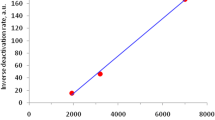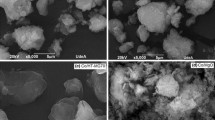Abstract
A number of supported cobalt catalysts for Fischer–Tropsch synthesis were considered. Catalysts were prepared by impregnation of the supports with a cobalt precursor resulting in cobalt concentrations of 15 or 20 wt%. The active metal was supported onto aluminum oxide, titanium dioxide and silicon carbide supports while rhenium or ruthenium metals were used as promoters, whose concentrations were 0, 0.2 or 1.0 wt%. The catalysts were characterized by a number of methods including BET, chemisorption, and XRD. Some of the catalysts were tested for catalytic activity and selectivity in the Fischer–Tropsch reaction using a fixed bed reactor. Based on the results, the addition of promoter metals increases the dispersion of the active metal cobalt and correspondingly a decrease in the cobalt metal particles, this effect was most evident for the alumina supported catalysts. Further, increased concentrations of the ruthenium promoter (1.0 wt%) slightly increased the selectivity to CH4 and decreased selectivity to C5+.





Similar content being viewed by others

References
Fiorese G, Catenacci M, Verdolini E, Bosetti V (2013) Advanced biofuels: future perspectives from an expert elicitation survey. Energy Policy 5(56):293–311
Khodakov AY, Chu W, Fongarland P (2007) Advances in the development of novel cobalt Fischer–Tropsch catalysts for synthesis of long-chain hydrocarbons and clean fuels. Chem Rev 107:1692–1744
Zhang W (2010) Automotive fuels from biomass via gasification. Fuel Process Technol 8(91):866–876
Tijmensen MJA, Faaij APC, Hamelinck CN, van Hardeveld MRM (2002) Exploration of the possibilities for production of Fischer–Tropsch liquids and power via biomass gasification. Biomass Bioenergy 8(23):129–152
Khodakov AY, Holmen A, Mirodatos C, Wang Y (2013) Catalysis and synthetic fuels: state of the art and outlook. Catal Today 215:1
Fiorese G, Catenacci M, Bosetti V, Verdolini E (2014) The power of biomass: experts disclose the potential for success of bioenergy technologies. Energy Policy 2(65):94–114
Hanaoka T, Liu Y, Matsunaga K, Miyazawa T, Hirata S, Sakanishi K (2010) Bench-scale production of liquid fuel from woody biomass via gasification. Fuel Process Technol 8(91):859–865
Ma W, Jacobs G, Keogh RA, Bukur DB, Davis BH (2012) Fischer–Tropsch synthesis: effect of Pd, Pt, Re, and Ru noble metal promoters on the activity and selectivity of a 25%Co/Al2O3 catalyst. Appl Catal A 437–438:1–9
Morales F, Weckhuysen BM (2006) Promotion effects in Co-based Fisher–Tropsch catalysis. Catalysis 19:1
Hackley VA, Stefaniak AB (2013) ‘‘Real-world’’ precision, bias, and between-laboratory variation for surface area measurement of a titanium dioxide nanomaterial in powder form. J Nanopart Res 15(1742):1–8
International Centre for Diffraction Data (ICDD) (2013) PDF-4 + powder diffraction database. 12 Campus Boulevard Newton Square, PA 19073-3273, USA
Hosseini SA, Taeb A, Feyzi F, Yaripour F (2004) Fischer–Tropsch synthesis over Ru promoted Co/γ-Al2O3 catalysts in a CSTR. Catal Commun 3(5):137–143
Iglesia E (1997) Design, synthesis, and use of cobalt-based Fischer–Tropsch synthesis catalysts. Appl Catal A 161:59–78
Storsæter S, Borg Ø, Blekkan EA, Holmen A (2005) Study of the effect of water on Fischer–Tropsch synthesis over supported cobalt catalysts. J Catal 231:405–419
Lillebø AH, Patanou E, Yang J, Blekkan EA, Holmen A (2013) The effect of alkali and alkaline earth elements on cobalt based Fischer–Tropsch catalysts. Catal Today 215:60–66
Blekkan EA, Holmen A, Vada S (1993) Alkali promotion of alumina-supported cobalt Fischer–Tropsch catalysts studied by TPR, TPD and pulse chemisorption. Acta Chem Scand 47:275–280
Borg Ø, Dietzel PDC, Spjelkavik AI, Tveten EZ, Walmsley JC, Diplas S et al (2008) Fischer–Tropsch synthesis: cobalt particle size and support effects on intrinsic activity and product distribution. J Catal 259:161–164
Acknowledgments
Authors would like to acknowledge the EU/Interreg Nord program (Project No. 304-8488-10) for its financial support within the HighBio2 project. The BRISK network and The Swedish Academy of Engineering Sciences in Finland are also acknowledged for awarding a Grant to H. Romar. Finally, many thanks go to Sasol, SiCat and Degussa for supplying the support materials.
Author information
Authors and Affiliations
Corresponding author
Rights and permissions
About this article
Cite this article
Romar, H., Lillebø, A.H., Tynjälä, P. et al. Characterisation and Catalytic Fischer–Tropsch Activity of Co–Ru and Co–Re Catalysts Supported on γ-Al2O3, TiO2 and SiC. Top Catal 58, 887–895 (2015). https://doi.org/10.1007/s11244-015-0455-0
Published:
Issue Date:
DOI: https://doi.org/10.1007/s11244-015-0455-0



